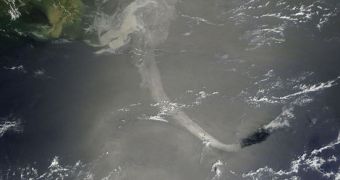The 12 crew members currently occupying the International Space Station (ISS) said yesterday that the Gulf of Mexico oil slick looked very alarming and scary from space. Astronauts from NASA, RosCosmos and JAXA took a moment from their busy schedule as they were flying over the Gulf on May 18, and took numerous pictures of the devastation, which may help authorities in charge of the clean-up effort to their job better. The Expedition 23 members said that they experienced a lot of discomfort when seeing the scale of the spill, which US officials are struggling hard to contain.
The Deepwater Horizon semi-submersible drilling rig, which operated only tens of miles south of the coasts of Louisiana, suffered a large explosion on April 20. Eleven crew members are assumed dead, and all rescue efforts aimed at finding them have long since been called off. On April 22, the rig sunk into the waters of the Gulf, in spite of the fact that emergency response ships were on-site, evacuating workers, and pouring water on the platform. With the collapse of the Horizon, the pipes that carried the oil from a depth of 5,000 feet (1,500 meters), broke.
The valves designed to stop the oil flow in such an instance malfunctioned, and approximately 5,000 barrels (210,000 US gallons; 790,000 liters) of crude have been spilling in the water daily ever since. Actual amount may be a lot larger than this, experts warn, which means that the damage is considerably larger than initially estimated. Given the size of the slick, some hypothesize that the oil may have moved from the site in underwater plumes, which are extremely difficult to detect. According to the ISS crew, to see the giant oil slick heading for the South Coast of the United States was a heartbreaking sight, Space reports.
“Just 30 minutes ago we passed over the Mexican Gulf and we took a lot of pictures of this oil spot. It looks very scary. It's not good. I really feel […] not good about that,” told reporters via video link Oleg Kotov, the RosCosmos cosmonaut that is now the Expedition 23 Commander. But the astronauts could also see the massive ash plumes that the Eyjafjallajokull glaciovolcano is currently emitting, from Iceland. “Yes, we can see ash above the Europe, especially in the evening hours. We cannot see the volcano itself. Many ecological problems we can observe and monitor from this space station. It's very useful for this perspective,” Kotov added.
“These things aren't good. When you fly around the planet you get to see the thumbprint of man all over the place,” said regretfully NASA astronaut Piers Sellers, who is an expert in ecology. He added that the oil slick was just the latest example in a long row of actions that man did to harm his own home world. There are numerous positive aspects of man's influence, Sellers believes, but the bad ones at times outweigh them by a considerable margin. “We're optimistic, I think, that people will eventually learn to look after the planet,” Sellers concluded.

 14 DAY TRIAL //
14 DAY TRIAL //